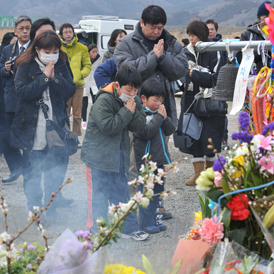Japan marks tsunami anniversary
People across Japan have prayed and stood in silence to remember the massive earthquake and tsunami that struck the nation one year ago.
The disaster on 3 March 2011 killed just over 19,000 people and unleashed the world’s worst nuclear crisis in a quarter century.
In the devastated northeastern coastal town of Rikuzentakata, a siren sounded at 2.46 pm (05.46 GMT), the exact time the magnitude-9.0 quake struck. A Buddhist priest in a purple robe rang a huge bell at a damaged temple overlooking a barren area where houses once stood.
The earthquake was the strongest recorded in Japan’s history, and set off a tsunami that swelled to more than 20 meters in some spots along the northeastern coast, destroying tens of thousands of homes and wreaking widespread destruction.
The tsunami also knocked out the vital cooling systems at the Fukushima Dai-ichi nuclear power plant, causing meltdowns at three reactors and spewing radiation into the air.
Some 100,000 residents who were forced to flee remain in temporary housing or with relatives, and a 12-mile area around the plant is still off limits.
Read more: The Japanese tsunami town on the move

‘I can’t find peace’
Toshiko Murakami, a 70-year-old resident of Rikuzentakata lost her sister in the tsunami.
“My sister is still missing so I can’t find peace within myself,” she said.
A long time friend of Murakami, Kazuko Otsuka, also a resident of Rikuzentakata, tearfully recalled last March 11.
She managed to get away by evacuating to higher grounds but her brother did not make it.
“I couldn’t even say goodbye to my brother and it still hurts deeply,” she said.
Otsuka said that many people were lost in the tsunami because no one expected the waters to reach inland.
All told, some 325,000 people rendered homeless or evacuated are still in temporary housing.
While much of the debris along the tsunami-ravaged coast has been gathered into massive piles, very little rebuilding has begun.
Beyond the massive cleanup, many towns are still finalising reconstruction plans, some of which involve moving residential areas to higher ground.
Bureaucratic delays in coordination between the central government, prefectural authorities and local officials have also slowed rebuilding efforts.




